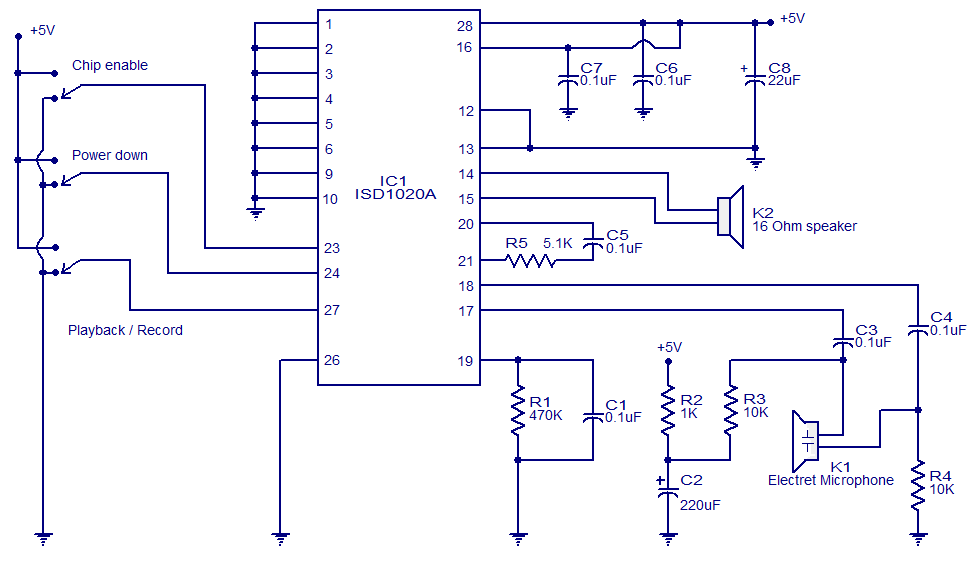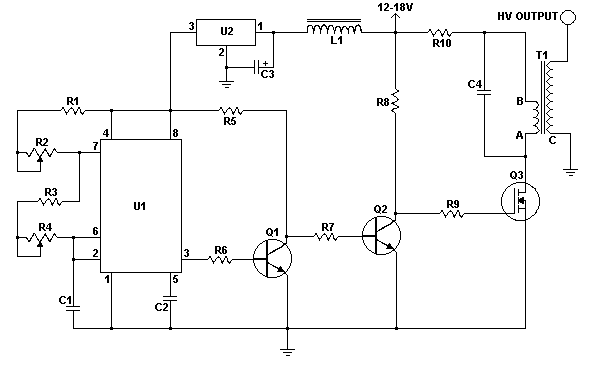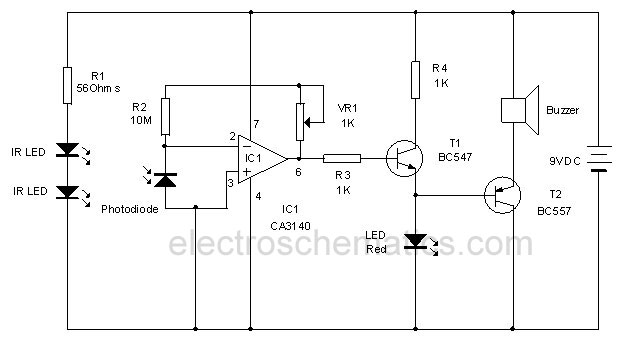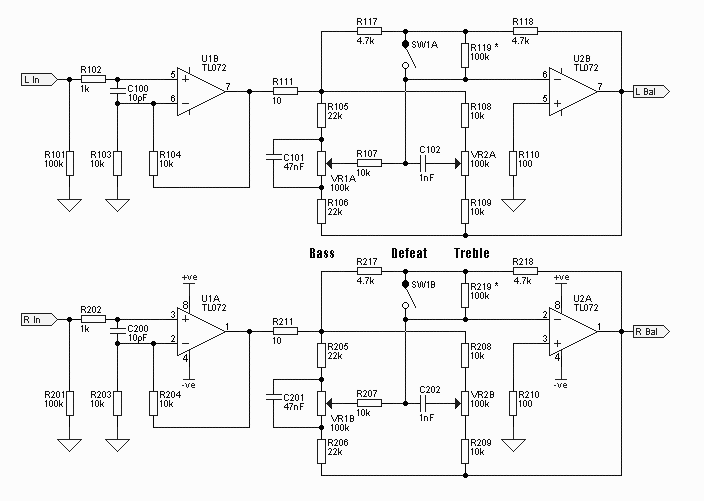
Audio Alarm Circuit

In the circuit, U1 amplifies the audio captured by the condenser microphone. Resistor R1 limits the current, while R2 and R3 center the amplifier's output to a voltage level of %B+ to facilitate the use of a single-ended power supply. Diodes D1 and D2 rectify the output from U1, and capacitor C3 filters the resulting pulsating DC. Consequently, a DC voltage that corresponds to the ambient sound level is generated. This voltage is fed into the non-inverting input of U2. The inverting input receives a reference voltage ranging from 0 to lAB+, which is determined by resistor R11. As long as the noise level remains sufficiently low to keep the voltage at pin 3 below the voltage at pin 2, the output of U2 remains low (approximately 1 V). This is adequate to partially bias transistor Q1. A voltage divider, created by resistors R8 and R10 in conjunction with Q1 (when it is partially on), prevents transistor Q2 from activating. When the noise level increases enough to elevate the voltage at pin 3 above that at pin 2, the output of U2 transitions to a high state. This fully turns on Q1, driving Q2 into saturation, resulting in the piezo buzzer sounding until power is removed.
The circuit operates as an audio level detector and alarm system, utilizing a combination of amplification, rectification, and signal processing to monitor ambient sound levels. The condenser microphone (U1) is the primary sensing element, converting acoustic signals into electrical signals. The output from U1 is conditioned by resistors R1, R2, and R3, which manage current flow and set the output voltage range, ensuring compatibility with single-ended power supplies. The rectification process performed by diodes D1 and D2 transforms the AC signal into a pulsating DC signal, which is then smoothed out by capacitor C3, providing a stable DC voltage that reflects the ambient sound level.
The operational amplifier U2 is configured in a comparator mode, comparing the processed voltage from the microphone with a reference voltage established by R11. The reference voltage can be adjusted to set a threshold for sound detection. When the ambient noise level exceeds this threshold, the output of U2 shifts from low to high, indicating that a significant sound event has occurred.
Transistor Q1 serves as a switch, initially biased into a partially on state by the low output from U2, while the voltage divider formed by R8 and R10 ensures that Q2 remains off during low noise conditions. Upon detection of elevated noise levels, Q1 is fully turned on, which in turn activates Q2. This action drives the piezo buzzer to emit sound, alerting users to the detected noise.
Overall, this circuit effectively combines audio sensing, signal processing, and alarm activation in a compact design, suitable for applications such as noise monitoring systems, alarms, and other sound-activated devices. In the circuit, U1 amplifies the audio picked up by the condenser microphone. Resistor Rl limits current, while R2 and R3 center the output of the amplifier to %B+ to allow a single-ended supply to be used. Diodes D1 and D2 rectify the output of Ul, and C3 filters the resulting pulsing dc. Thus, a dc voltage that is proportional to the ambient sound level is produced.That voltage is presented to the noninverting input of U2.
The inverting input is provided with a reference voltage of between 0 and lAB+, which is set by Rll.As long as the noise level is low enough to keep the voltage at pin 3 lower than the voltage at pin 2, the output of U2 stays low (approximately 1 V). That is enough to bias Ql partially on. A voltage divider, formed by R8/R10 and Ql (when it`s partially on), prevents Q2 from turning on.When the noise level is high enough to bring the voltage at pin 3 higher than the voltage at pin 2, the output of U2 goes high. That turns Ql fully on and drives Q2 into saturation. The piezo buzzer then sounds until the power is cut off.
The circuit operates as an audio level detector and alarm system, utilizing a combination of amplification, rectification, and signal processing to monitor ambient sound levels. The condenser microphone (U1) is the primary sensing element, converting acoustic signals into electrical signals. The output from U1 is conditioned by resistors R1, R2, and R3, which manage current flow and set the output voltage range, ensuring compatibility with single-ended power supplies. The rectification process performed by diodes D1 and D2 transforms the AC signal into a pulsating DC signal, which is then smoothed out by capacitor C3, providing a stable DC voltage that reflects the ambient sound level.
The operational amplifier U2 is configured in a comparator mode, comparing the processed voltage from the microphone with a reference voltage established by R11. The reference voltage can be adjusted to set a threshold for sound detection. When the ambient noise level exceeds this threshold, the output of U2 shifts from low to high, indicating that a significant sound event has occurred.
Transistor Q1 serves as a switch, initially biased into a partially on state by the low output from U2, while the voltage divider formed by R8 and R10 ensures that Q2 remains off during low noise conditions. Upon detection of elevated noise levels, Q1 is fully turned on, which in turn activates Q2. This action drives the piezo buzzer to emit sound, alerting users to the detected noise.
Overall, this circuit effectively combines audio sensing, signal processing, and alarm activation in a compact design, suitable for applications such as noise monitoring systems, alarms, and other sound-activated devices. In the circuit, U1 amplifies the audio picked up by the condenser microphone. Resistor Rl limits current, while R2 and R3 center the output of the amplifier to %B+ to allow a single-ended supply to be used. Diodes D1 and D2 rectify the output of Ul, and C3 filters the resulting pulsing dc. Thus, a dc voltage that is proportional to the ambient sound level is produced.That voltage is presented to the noninverting input of U2.
The inverting input is provided with a reference voltage of between 0 and lAB+, which is set by Rll.As long as the noise level is low enough to keep the voltage at pin 3 lower than the voltage at pin 2, the output of U2 stays low (approximately 1 V). That is enough to bias Ql partially on. A voltage divider, formed by R8/R10 and Ql (when it`s partially on), prevents Q2 from turning on.When the noise level is high enough to bring the voltage at pin 3 higher than the voltage at pin 2, the output of U2 goes high. That turns Ql fully on and drives Q2 into saturation. The piezo buzzer then sounds until the power is cut off.





